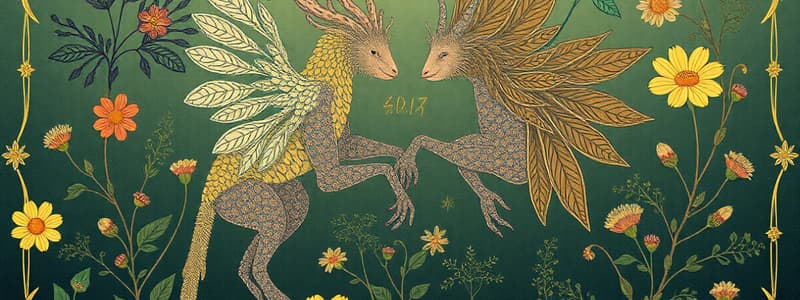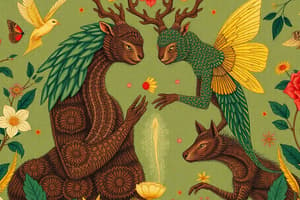Podcast
Questions and Answers
Describe the mutualistic relationship between coral and Zooxanthellae, highlighting the benefits to both organisms.
Describe the mutualistic relationship between coral and Zooxanthellae, highlighting the benefits to both organisms.
Coral provides Zooxanthellae with a protective habitat and carbon dioxide, while Zooxanthellae supply coral with oxygen and glucose from photosynthesis.
Explain how honey bees contribute to plant reproduction through their interaction with flowers.
Explain how honey bees contribute to plant reproduction through their interaction with flowers.
Honey bees collect nectar from flowers and distribute pollen, facilitating the fertilization process necessary for plant reproduction.
What is the role of plover birds when interacting with crocodiles, and how does this define their relationship?
What is the role of plover birds when interacting with crocodiles, and how does this define their relationship?
Plover birds clean crocodiles' teeth by removing food particles, benefiting both by providing dental hygiene to the crocodiles and gaining a food source for themselves.
Identify the symbiotic relationships involving mistletoe birds and mistletoe plants, and explain their significance.
Identify the symbiotic relationships involving mistletoe birds and mistletoe plants, and explain their significance.
Discuss how sea anemones and clownfish exemplify a mutualistic relationship.
Discuss how sea anemones and clownfish exemplify a mutualistic relationship.
Explain the significance of the relationship between koalas and bacteria in their digestive systems.
Explain the significance of the relationship between koalas and bacteria in their digestive systems.
Outline how the concepts of mutualism, commensalism, and parasitism differ in terms of organism interaction and benefits.
Outline how the concepts of mutualism, commensalism, and parasitism differ in terms of organism interaction and benefits.
Define symbiosis and provide an example of a symbiotic relationship.
Define symbiosis and provide an example of a symbiotic relationship.
Differentiate between mutualism and commensalism with examples.
Differentiate between mutualism and commensalism with examples.
Explain how mutualism can be vital for the survival of certain species.
Explain how mutualism can be vital for the survival of certain species.
What role do mistletoe birds play in their mutualistic relationship with mistletoe plants?
What role do mistletoe birds play in their mutualistic relationship with mistletoe plants?
Discuss an example of parasitism and how it contrasts with mutualism.
Discuss an example of parasitism and how it contrasts with mutualism.
What is the significance of bacteria in the digestive system of mammals like koalas?
What is the significance of bacteria in the digestive system of mammals like koalas?
Describe how symbiotic relationships can be classified and provide one characteristic of each type.
Describe how symbiotic relationships can be classified and provide one characteristic of each type.
Why might symbiotic relationships be advantageous but not strictly necessary for some species?
Why might symbiotic relationships be advantageous but not strictly necessary for some species?
Flashcards
Symbiosis
Symbiosis
A close, long-term interaction between two different species, where at least one species benefits.
Symbiont
Symbiont
An organism involved in a symbiotic relationship.
Mutualism
Mutualism
A symbiotic relationship where both species benefit.
Mutualism Example (Oxpeckers)
Mutualism Example (Oxpeckers)
Signup and view all the flashcards
Mutualism Example (Anemones and Clownfish)
Mutualism Example (Anemones and Clownfish)
Signup and view all the flashcards
Mutualism Example (Mistletoe)
Mutualism Example (Mistletoe)
Signup and view all the flashcards
Mutualism Example (Mammals and Gut Bacteria)
Mutualism Example (Mammals and Gut Bacteria)
Signup and view all the flashcards
Commensalism
Commensalism
Signup and view all the flashcards
Parasitism
Parasitism
Signup and view all the flashcards
Symbiotic relationship
Symbiotic relationship
Signup and view all the flashcards
Mutualism
Mutualism
Signup and view all the flashcards
Coral and Zooxanthellae
Coral and Zooxanthellae
Signup and view all the flashcards
Oxpeckers and zebra
Oxpeckers and zebra
Signup and view all the flashcards
Sea anemones and clownfish
Sea anemones and clownfish
Signup and view all the flashcards
Mistletoe and birds
Mistletoe and birds
Signup and view all the flashcards
Honeybees and flowers
Honeybees and flowers
Signup and view all the flashcards
Crocodiles and plover birds
Crocodiles and plover birds
Signup and view all the flashcards
Koala and bacteria
Koala and bacteria
Signup and view all the flashcards
Study Notes
Symbiosis
- Symbiosis is a close and persistent (long-term) interaction between two species.
- Symbiotic relationships can be required for survival or advantageous without being strictly necessary.
- The interaction can benefit one or both organisms.
- Each species involved is called a symbiont.
- Examples include mutualism, commensalism, and parasitism.
Mutualism
- Mutualism is a partnership where both species benefit from the interaction.
- This is a prolonged association.
- Oxpeckers stand on cattle; they feed on parasites on the host.
- The birds benefit from an easy source of food, while the host benefits from parasite removal.
- Honeybees get nectar from flowers and distribute pollen between plants.
- Plover birds pick food from crocodiles' jaws, cleaning their teeth.
- Zooxanthellae (algae) live within coral: when the algae photosynthesise, they provide glucose (food) for the coral.
- Reef-building coral forms a symbiotic relationship with the algae. Coral provides shelter, and carbon dioxide to the algae, while algae produce oxygen and sugar for the coral.
- Some species of anemones coexist with clownfish, each highly dependent on the other.
- Clownfish benefit from a safe and protective home; they also benefit the anemone by cleaning it, providing nutrients, and scaring away predators (like butterflyfish).
- Mistletoe birds depend on mistletoe fruits for food. They disperse the seed in their waste, allowing the plants to germinate and grow.
- Many mammals that consume plants have bacteria in their guts, which help them digest the grass. Koalas have a long caecum containing millions of bacteria that break down plants into smaller molecules.
Other Symbiotic Relationships
- Commensalism - one species benefits, the other is unaffected.
- Parasitism - one species benefits, the other is harmed.
Studying That Suits You
Use AI to generate personalized quizzes and flashcards to suit your learning preferences.




